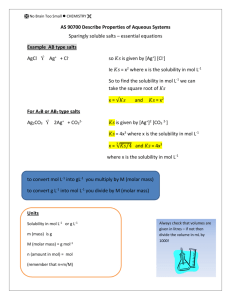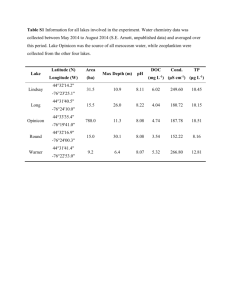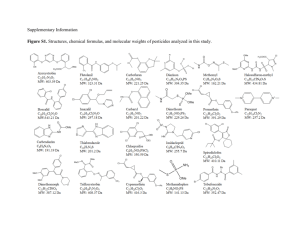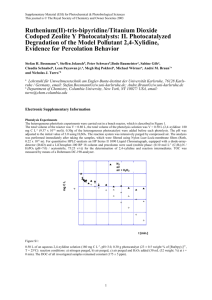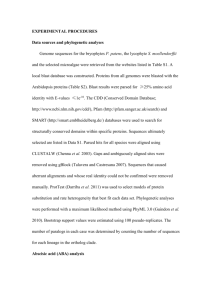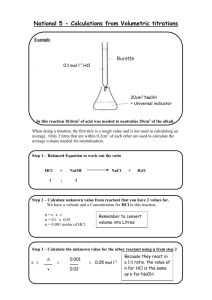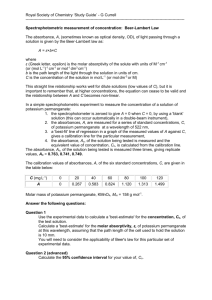Metwali et al (pre-submission) 2014
advertisement
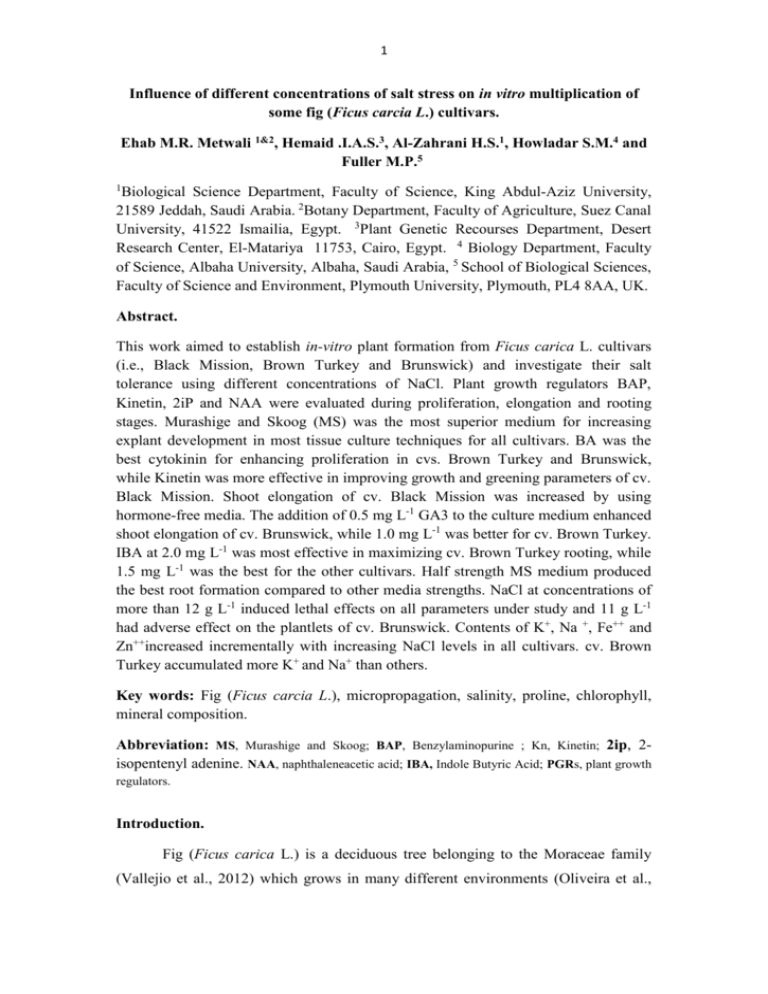
1 Influence of different concentrations of salt stress on in vitro multiplication of some fig (Ficus carcia L.) cultivars. Ehab M.R. Metwali 1&2, Hemaid .I.A.S.3, Al-Zahrani H.S.1, Howladar S.M.4 and Fuller M.P.5 1 Biological Science Department, Faculty of Science, King Abdul-Aziz University, 21589 Jeddah, Saudi Arabia. 2Botany Department, Faculty of Agriculture, Suez Canal University, 41522 Ismailia, Egypt. 3Plant Genetic Recourses Department, Desert Research Center, El-Matariya 11753, Cairo, Egypt. 4 Biology Department, Faculty of Science, Albaha University, Albaha, Saudi Arabia, 5 School of Biological Sciences, Faculty of Science and Environment, Plymouth University, Plymouth, PL4 8AA, UK. Abstract. This work aimed to establish in-vitro plant formation from Ficus carica L. cultivars (i.e., Black Mission, Brown Turkey and Brunswick) and investigate their salt tolerance using different concentrations of NaCl. Plant growth regulators BAP, Kinetin, 2iP and NAA were evaluated during proliferation, elongation and rooting stages. Murashige and Skoog (MS) was the most superior medium for increasing explant development in most tissue culture techniques for all cultivars. BA was the best cytokinin for enhancing proliferation in cvs. Brown Turkey and Brunswick, while Kinetin was more effective in improving growth and greening parameters of cv. Black Mission. Shoot elongation of cv. Black Mission was increased by using hormone-free media. The addition of 0.5 mg L-1 GA3 to the culture medium enhanced shoot elongation of cv. Brunswick, while 1.0 mg L-1 was better for cv. Brown Turkey. IBA at 2.0 mg L-1 was most effective in maximizing cv. Brown Turkey rooting, while 1.5 mg L-1 was the best for the other cultivars. Half strength MS medium produced the best root formation compared to other media strengths. NaCl at concentrations of more than 12 g L-1 induced lethal effects on all parameters under study and 11 g L-1 had adverse effect on the plantlets of cv. Brunswick. Contents of K+, Na +, Fe++ and Zn++increased incrementally with increasing NaCl levels in all cultivars. cv. Brown Turkey accumulated more K+ and Na+ than others. Key words: Fig (Ficus carcia L.), micropropagation, salinity, proline, chlorophyll, mineral composition. Abbreviation: MS, Murashige and Skoog; BAP, Benzylaminopurine ; Kn, Kinetin; 2ip, 2isopentenyl adenine. NAA, naphthaleneacetic acid; IBA, Indole Butyric Acid; PGRs, plant growth regulators. Introduction. Fig (Ficus carica L.) is a deciduous tree belonging to the Moraceae family (Vallejio et al., 2012) which grows in many different environments (Oliveira et al., 2 2012) and soil types (Vemmos et al., 2013). It is recognised to have the ability to tolerate water deficit and moderate salinity stress (Golombek and Lodders, 1993) making it a suitable species for cultivation in semi-arid environments such as the Meditteranean and middle-East where it is an important crop plant. According to Borrino (1992), salinity is a chief factor limiting the growth of many plant species throughout the world and it has been estimated that around 831 million hectares were affected by salinity in the world (Rengasamy, 2006). In semiarid areas, limited water and hot dry climates necessitate irrigation by ground water containing salts and these can cause transient salinity or in many cases lead to a buildup of salinity that limits or eventually prevents crop production (Rady et al., 2013). In Saudi Arabia more than 90% of agriculture depends upon groundwater irrigation (ElJuhany and Aref, 2005) and the intensive evaporation of surface irrigation water and the local hydrogeological conditions increase the risk of groundwater salinity and leads to eventual rooting horizon salt stress (Alyamani, 1999; Subyani, 2005). An increase in the salinity of soil water inhibits the germination and root elongation in most plants because it reduces water uptake, water use efficiency and relative water content (Howladar, 2014) and inhibits K, Ca and NO3 uptake by plant roots (Howladar and Rady, 2012). It has been shown that salinity reduces gas exchange parameters, growth parameters and yield and yield components of fig (Essam et al., 2013) as well as causing a reduction in leaf chlorophyll and a reduction in photosynthesis. In response to reductions in photosynthetic rate salinity elevates antioxidant enzymes and proline content as a stress response to deal with increased levels of Reactive Oxygen Species (ROS). As well as this stress most plants are unable to discriminate between the ions K+ and Na+ and in saline conditions take up and accumulate high levels of Na+ to the detriment of the necessary quantities of K+ leading to loss of function of K+ dependent reactions and leading to Na+ induced toxicity (Ruhan et al., 2004). In order to have effective utilization of salt affected soils it is important to identify fig genotypes which tolerate salinity and produce substantial yield under adverse soil environment and utilize the heritable variation present in the germplasm to propagate resilient genotypes or to utilize these in a breeding programme. Targeted breeding in fig can play a major role in narrowing the gap between supply and demand through utilizing improved varieties that can be grown under abiotic stress conditions. 3 Cell and tissue culture systems have been used for selection of plant tolerance to abiotic stresses including salinity, drought, and other stresses (Luttus et al., 1999; Fuller et al., 2006; Shibli et al., 2007; Zattimeh et al., 2007; Shatnawi et al., 2009). Simple screening of plantlets by tissue culture under abiotic or biotic stress provides an opportunity for studying many aspects of plant growth and development under well-defined conditions (Shatnawi et al., 2004). Moreover, tissue culture provides an important tool for studying the physiological effects of salt at the cellular level under controlled environment (Shatnawi et al., 2011a). The employment of biotechnological approaches to improve horticultural crop production it is a powerful tool for largescale propagation of horticultural crops (Chebet et al., 2003). In vitro propagation through meristem culture is the best possible means of producing a large numbers of plants in a short span of time and frequently has the advantage of virus elimination or reduction. Also conserved material can be maintained (disease-free) in vitro and easily exchanged between countries with much reduced phytosanitary risk (Chaohong et al., 2013; Shatnawi et al., 2011b; Thorpe and Harry, 1997). It has already been shown that in-vitro culture can produce rejuvenated mature fig plantlets (Hemaid et al., 2009). Therefore, the objective of the present study was to optimize an in vitro plant regeneration system for three Saudi cultivars of fig, as a prerequisite for improvement of local produciton through genetic transformation and furthermore to investigate the in vitro response of fig when being subject to NaCl stress. Material and methods 1. Establishment of in vitro culture 1.1. Explant material Shoot tip explants were collected in summer and autumn from healthy 7 to 8 years-old mature trees of Ficus carica L cvs. Black Mission, Brown Turkey and Brunswick in Hofuf, Saudi Arabia. 1.2. In vitro propagation of fig. The experiment was conducted to study in vitro assessment of NaCl induced salt stress in shoot formation of fig. Shoot tips were washed in running tap water and then explants were surface-sterilized by a 15 sec immersion in 70% (v/v) ethanol followed by 15 min in aqueous solution of 2.5% (v/v) sodium hypochlorite. After 4 three subsequent washes in sterile double distilled water, shoot tips were removed and rinsed 3-4 times with sterile antioxdant solution (150 mg L-1 citric acid and 100 mg L-1 ascorbic acid) to avoid browning of tissues (Hemaid et al., 2000). Sterilized shoot tips were cultured on MS medium (Murashige and Skoog, 1962) supplemented with different concentrations of 1.0 – 2.0 mg L-1 benzyl amino purine (BAP) combined with 0.5 mg L-1 Kinetin or 0.5 – 1.0 mg L-1 BAP combined with 0.5 mg L-1 2-isopentenyl adenine (2iP) or 1.0 – 2.0 mg L-1 BAP combined with 0.5 – 1.0 mg L-1 naphthaleneacetic acid (NAA) in order to determine the best concentrations for shoot formation. The pH of the medium was adjusted to 5.8 using 0.1N NaOH or HCl and the medium was solidified with 0.25% phytagel before autoclaving. The cultures were incubated at 25 ± 1°C in a 16h photoperiod under 50 µmol m-2 s-1 illumination supplied by cool, white fluorescent light. 1.3. In vitro multiplication For shoot multiplication, microshoots (15 - 20 mm in length) were sub-cultured to MS medium supplemented with either BAP alone or in combination with Kinetin or 2iP. The pH of the MS medium was adjusted to 5.7. Media were dispensed into 370 mL jars (20 mL/jar) and autoclaved at 121°C. Cultures were incubated in the growth cabinet and after a six weeks data were collected on shoot length and the number of shoots per explant. 1.4. In vitro root formation and acclimatization. Shoots (3 cm in length) derived from the multiplication stage were subcultured to hormone-free MS medium for two weeks to eliminate any hormone carryover effects and then transferred to MS medium supplemented with 100 mg L-1 myoinositol, 30 g L-1 sucrose and 1.0 - 2.0 mg L-1 Indole Butyric Acid (IBA) alone or combined with 0.0 - 0.5 mg L-1 NAA. Cultures were incubated under the same environmental conditions used for shoot proliferation for a 4 week culture period. Rooted plantlets produced from the rooting stage were transferred from their test tubes to plastic pots containing peat-moss and sand (1:1). Pots were enveloped in polyethylene bags and were incubated under 50 µmol m-2 s-1 light intensity derived from cool white fluorescent lamps for 16 hours photoperiod at 25 ±1°C in a growth cabinet. Four weeks later bags were completely opened and bags were removed after a further four weeks and plantlets were transferred and maintained under greenhouse conditions as described by Hemaid et al., (2010). 5 2. Effect of salinity 2.1. Growth characters Microshoots 5 - 10 mm in length with two leaves were sub-cultured on MS proliferation medium containing 2.0 mg L-1 BAP and 0.5 mg L-1 2iP and supplemented with different concentration of NaCl (0, 2, 4, 6, 8, 9, 10, 11 and 12 g L1 ) the highest concentration was equivalent to 207 mM and was 43% of the concentration of seawater. Each treatment consisted of 4 replicates and each experiment was repeated twice. Differences between individual treatments were determined with the least significant difference (LSD) at 0.05 level of probability. Data were collected on shoot length, number of shoot per explants, fresh weight, and dry weights after a six week growth period. 2.2. Mineral composition Plant samples were oven dried at 80°C for 24 h and were ground using a pestle and mortar for determination of mineral composition. Ash of plant samples was dissolved in 5.1% HNO3 and used to determine sodium (Na), potassium (K), iron (Fe) and zinc (Zn) contents using an atomic absorption spectrophotometer. 2.3. Chlorophyll content A 0.5 g fresh weight sample of leaves was taken per replicate after 6 weeks exposure to salt stress. Samples were extracted by acetone, following the method of De Filippis et al. (1981). Samples were homogenized in 2.0 mL of 80% acetone using a pestle and mortar. The extract was pipetted into a 2.0 mL microtube and centrifuged at 15000 g for 2 min. The clear green supernatant was collected using a Pasteur pipette, and made up to 3.0 mL in a 10 mL measuring cylinder with extra 80 % acetone. The absorption spectra were measured by spectrophotometer (Smart Spec™ 3000 Bio-Rad) at 510 665 nm absorbance. Chlorophyll a, and Chlorophyll b contents were calculated according to Anderson and Boardman (1964). 3.4. Proline determination Proline colorimetric determination was according to Bates et al., (1973). Fresh leaf tissue (200 mg) was homogenized with 4 mL of 50 mM phosphate buffer (pH 7.8) 6 containing 1% (w/v) polyvinyl pyrrolidone (PVP) 0.01% (w/v) Triton X-100, and centrifuged at 800 rpm for 15 min. Proline was determined in the supernatant by measuring the absorbance of proline-ninhydrin product formed at 520 nm in a spectrophotometer using toluene as a solvent. 3. Statistical analysis Analysis of variance was computed for various treatments and significant differences between means using the LSD (0.05), (Snedecor and Cocharn, 1967). In all tables means followed by the same letter are not significantly different. Data were analyzed using Costat statistic programme. Results and Discussion 1. In vitro propagation of fig (Ficus carica L.) 1.1. Culture establishment MS basal medium supplemented with various concentrations and combinations of BA, Kinetin, 2iP and NAA showed that shoot tips of the three studied cultivars of fig could survive and form axillary shoots on all the media tested (Plate 1). In general, the results indicated that the induction of shoots and length of shoots differed depending on the concentration of growth regulator added to the regeneration medium (Table 1). Media containing 1.0 mg L-1 BAP and 0.5 mg L-1 NAA, 2.0 mg L-1 BAP and 0.5 mg L-1 NAA and 2.0 mg L-1 BAP and 1.0 mg L-1 NAA were the most effective for the both induction of shoots and increase in length of shoots in cvs, Black Mission, Brown Turkey and Brunswick, respectively. Also, in the present study, variation between these cultivars for number of shoots per explants and length of shoots were not statistically significant (Table 1).The results agree with previous studies for the micropropagation of Ficus carica using shoot tips and nodal explants of cultivars Conadria, Abiad and Sultani (Hemaid et al., 2000 ; 2010). The results are in agreement of those Khan et al., (2009) who indicated that the highest value of mean number of shoots per explants was (2.34) when leaves were cultured on MS medium supplemented with 2.0 mg L-1 BAP and 1.0 mg L-1 NAA. 1.2. Shoot multiplication 7 Multiplication is a rapid increase of organs which can ultimately give rise to plant and is achieved by enhancing axillary shoot initiation (Murashige, 1974). This stage is repeated at regular intervals to produce large-scale shoot multiplication to be commercially useful (Smith and Murashige, 1970). In the present study, different concentrations of benzyl adenine BA alone or in combination with Kinetin or 2iP was applied. The average number shoot per explant produced from shoot tips of cvs. Black Mission and Brunswick were greatest (2.85-2.97) using the medium containing 3 mg L-1 BAP + 0.5 mg L-1 2iP and had the longest shoot lengths (7.25 - 6.75 cm) (Table 2). For cv. Bown Turkey however, the increase in mean number of axillary shoot per explant was significantly higher on the medium containing 3 mg L-1 BAP with 0.5 mg L-1 Kinetin and had the maximum shoot length (6.85) (Plate 2). It is clear from the Table (2) that the increase in mean lengths of axillary shoots growing on MS medium containing 3 mg L-1 BAP + 0.5mg L-1 2iP were significant, it recorded 2.98 and 2.85 cm for Black Mission and Brunswick, respectively comparing to the other treatments which were less significant. However, using 2 mg L-1 BAP + 0.5 mg L-1 2iP gave the highest increase in axillary shoot length (2.79 cm) compared to the increase in mean length of the other treatments range (1.0 - 2.56 cm) for Brown Turkey. It can be recommended to use 3.0 mg L-1 BAP + 0.5 mg L-1 2iP for increasing number and the length of axillary shoots for all three cultivars. From the results of multiplication stage of shoots produced from shoot tip of all cultivars the best results for shoot multiplication and the rate of propagation was 1: 7.25 for Black Mission, 1: 6.75 of Brunswick on MS medium containing 3 mg L-1 BAP + 0.5 mg L-1 2iP and 1:6.85 for Brown Turkey on MS medium containing 3 mg L-1 BAP + 0.5 mg L-1 Kinetin. This result agrees with Hemaid et al., (2000) who found that the best results for shoot multiplication and the rate of propagation of fig was 4.17 - 5.0 over a five week period for cvs. Conadria and Sultani, respectively on MS medium containing 3 mg L-1 BAP + 0.5 mg L-1 2iP. Haelterman et al., (1994) found that the best results for shoot multiplication and the rate of propagation of fig was 1:4 to 1:6.0 every 45 days on a basal medium (BM) containing MS inorganic salts + 0.5 mg L-1 Kinetin and 0.1 mg L-1 GA3. These results are also in agreement with Pontikis and Melas (1986) who mentioned that 1 - 2 new shoots of fig during the first 4 weeks and after 8 weeks produced the highest multiplication rate of 15 - 20 shoots on MS medium containing 0.1 mg L-1 IBA + 0.1 mg L-1 GA3 + 0.5 mg L-1 BA. 8 Table 1. In vitro establishment of shoot tips of Ficus carica L. cvs. Black Mission, Brown Turkey and Brunswick cultured on MS nutrient medium supplemented with BAP, Kinetin, 2iP and NAA for five weeks from initial culture. PGRs conc. (mg L-1) Mean number of shoots/explant Black Mission Brown Turkey Brunswick Mean length of shoots (cm) Black Mission Brown Brunswick Turkey MS control medium (without PGRs) 1.0 BA and 0.5 Kin 0.00f 0.00f 0.00f 0.00f 0.00f 0.00f 1.25d 1.33c 1.25d 2.71b 2.08b 1.82e 2.0 BA and 0.5 Kin 1.34c 1.40b 1.20e 2.01d 2.27d 2.30c 0.5 BA and 0.5 l 2iP 1.25d 1.25d 1.15d 2.45d 2.22d 2.25d 1.0 BA and 0.5 2iP 1.33c 1.18e 1.35c 2.55b 2.48b 2.14d 0.5 BA and 0.5 NAA 1.41b 1.26d 1.25d 2.84b 2.25c 2.65c 1.0 BA and 0.5 NAA 1.85a 1.25d 1.15e 2.99a 2.54c 2.90ab 2.0 BA and 0.5 NAA 1.33c 1.54a 1.05e 2.79bc 2.96a 2.87bc 1.0 BA and 1.0 NAA 1.40b 1.35c 1.30c 1.98e 1.95e 1.93e 2.0 BA and 1.0 NAA 1.42b 1.26d 1.78a 2.83b 2.90ab 2.93a Averages followed by the same letter within a column are not significantly different at P ≤ 0.05 Table 2. Multiplication of in vitro proliferated shoots of Ficus carica L. cvs. Black Mission, Brown Turkey and Brunswick cultured in tissue culture jars for five weeks on MS nutrient medium supplemented with different concentrations of BA alone or in combination with 2iP or Kinetin using shoots produced from shoot tips. Cytokinins conc. (mg l-1) BA 2iP Kin Average no. of shoots explant-1 Black Mission Brown Turkey Brunswick Average length of shoots (cm) Black Mission Brown Brunswick Turkey 1.0 0.0 0.0 2.53f 1.45g 2.25f 1.20d 1.00e 1.34d 2.0 0.0 0.0 3.14e 3.02e 3.00e 1.15d 1.25d 1.18d 3.0 0.0 0.0 4.85d 4.64d 4.73d 1.00e 1.35d 1.17d 1.0 0.5 0.0 3.87e 3.17e 3.56e 1.75c 1.68c 1.66c 2.0 0.5 0.0 4.65d 4.05d 4.12d 2.23b 2.79a 2.13b 3.0 0.5 0.0 7.25a 5.18c 6.75b 2.98a 2.17b 2.85a 2.0 0.0 0.5 3.20e 3.05e 3.18e 1.85c 1.35d 1.58c 3.0 0.0 0.5 5.18c 6.85b 6.12b 1.52c 2.56b 2.25b Averages followed by the same letter within a column are not significantly different at P ≤ 0.05 . 9 Black Mission Brown Turkey Brunswick Plate 2. Shoot multiplication of Ficus carica L. cvs. of Black Mission, Brown Turkey and Brunswick on MS medium supplemented with BAP and 2iP. 1.3. Rooting and ex vitro acclimatization All treatments produced some rooting (68 - 93%) for Black Mission, (6789%) for Brown Turkey and (58- 92%) for Brunswick. The percentage of shoots forming roots was highest (96 and 98%) in cvs. Black Mission and Brown Turkey, respectively using MS phytagel gelled nutrient medium supplemented with 1.0 mg L-1 IBA and 0.5 mg L-1 NAA with 2 mg L-1 activated charcoal under 28 days of light (Table 3) (Plate 3). For cv. Brunswick the best rooting (97%) was using MS phytagel gelled nutrient medium supplemented with 1.5 mg L-1 IBA and 0.5 mg L-1 NAA. Mean number of roots formed on the explant treated with 1 mg L-1 IBA and 0.5 mg L1 NAA was significantly higher than the other treatments, reaching 5.46 for Black Mission and 5.88 for Brown Turkey. However, the mean number of roots for the other treatments ranged from 1.85 – 4.88 of Black Mission and (1.25 - 4.56) for Brown Turkey and that treated 1.5 mg L-1 IBA + 0.5 mg L-1 NAA was significantly higher 10 than the other treatments reaching 5.17 for Brunswick while mean number of the other treatments ranged from 1.48 - 4.25. The different treatments used gave significant differences between the cultivars in the total mean number of roots. The mean length of roots formed on the explant treated with 1mg L-1 IBA and 0.5 mg L-1 NAA were significantly higher than the other treatments reaching to 4.92 and 5.68 cm for Black Mission and Brown Turkey, respectively. However, mean length of roots formed on the explant treated with 1.5 mg L-1 IBA and 0.5 mg L-1 NAA for Brunswick was significantly higher compared with the other treatments reaching 6.47 cm while the mean lengths of the other treatments were 1.05 - 4.15 cm. These results agree with those obtained by Pontikis and Melas (1986) who reported that the higher rooting responses (80%) for fig were obtained after 28 days in light on MS medium containing 1 mg L-1 IBA. However, Muriithi et al., (1982) reported that shoots of fig were rooted on MS medium with 0.5 mg L-1 NAA + 0.5 mg L-1 IBA in darkness for 7 days and transfer to in the presence of light for 3 weeks. Plants produced from the rooting stage were transfer to a green house and after 8 weeks from transfer into the green house they were repotted into sterile soil consists equal parts of peat and sand (v/v) (Plate 4). A similar method has been reported by (Hemaid et al., 2010 and Pontikis and Melas (1986), who reported that for acclimatization of Ficus Carica L. the plantlets were transplanted into pots containing equal parts of peat and vermiculite (v/v) before transfer to a greenhouse after 4 weeks. After 8 weeks they were repotted into sterile soil containing equal parts of peat and vermiculite (v/v). 2. Salinity stress 2.1. Growth parameters responses to salinity levels Effect of NaCl on shoot length, number of new shoots, fresh weight, and dry weight after four weeks growth periods on MS medium supplemented with 3.0 mg L-1 BA and 0.5 mg L-1 2iP were reported (Plate 5; Figure 1). Data in Figure 1 indicate that the application of the different concentration of NaCl to Ficus carica L cultivars Black Mission, Brown Turkey and Brunswick after four weeks of treatments. Table 3. The efficiency of shoots forming roots for Ficus carica L cvs. Black Mission, Brown Turkey and Brunswick after growing on MS medium supplemented with different auxin concentrations. Auxin con. mg L-1 % of Root formation Mean number of roots/explant Mean length of roots (cm) 11 IBA NAA Black Brown Mission Turkey Brunswick Black Brown Mission Turkey Brunswick Black Brown Mission Turkey Brunswick 0.5 0.0 68e 67e 58f 1.85f 1.25f 1.48f 1.00f 0.98f 1.05f 1.0 0.0 89b 91ab 89b 3.55d 3.48d 3.36d 2.02e 2.88e 2.18e 1.5 0.0 88b 86b 93ab 3.76d 3.78d 3.68d 2.66e 3.28d 2.0 0.0 83c 81c 85b 2.48e 3.56d 2.25e 3.07d 3.18d 2.35e 2.04e 0.5 0.5 73d 75d 68e 4.15c 4.23b 4.04c 2.10e 3.00d 2.89de 1.0 0.5 96a 98a 92ab 5.46a 5.88a 4.25b 4.92c 5.68b 4.15cd 1.5 0.5 93ab 89b 97a 4.88ab 4.56ab 5.17a 4.88c 6.47a 2.0 0.5 85b 83c 87b 4.00c 4.03c 4.18b 4.25cd 4.78c 3.25d 3.36d Averages followed by the same letter within a column are not significantly different at P ≤ 0.05 Black Mission Brown Turkey Brunswick Plate 3. Well established plants of Ficus carica cvs. Black Mission, Brown Turkey and Brunswick on MS medium supplemented with 1 mg L-1 IBA and 0.5 mg L-1NA ready for weaning (healthy plantlets with normal roots). Plate 4. Acclimatization and establishment of ex-vitro plants of Ficus carica cvs. Black Mission, Brown Turkey and Brunswick under greenhouse conditions . Generally, shoot length, number of newly formed shoots, fresh weight and dry weight were decreased with the increased salt concentration in the medium (Figure 1). Plantlet length ranged from 0.13 to 2.98 cm. The greatest plantlets length was found in 2 g L-1 (with values of 2.18, 2.04 and 2.15 cm) for cvs.. Black Mission, Brown 12 Turkey and Brunswick, respectively and the smallest value was recorded at 11 g L-1 compared with other the treatments (Figure 1a). Whereas, the number of newly formed shoots of Ficus carica L cultivars Brown Turkey and Brunswick exhibited a significant decrease with 12 g L-1 of NaCl concentration. However, the highest value was recorded by control (0.0) and 2 g L-1 the other treatments came in between compared with other treatments (Figure 1b). Fresh weight was increased with the increase in NaCl concentration. Maximum fresh weight (2345.4, 2145.8 and 2235.2 mg) was obtained at 4000 ppm NaCl of cvs. Black Mission, Brown Turkey and Brunswick, respectively and the minimum fresh weight (170.3 mg) was obtained at 12 g L-1 NaCl for Black Mission while the plantlets at this concentration of cultivar Brown Turkey and Brunswick both died(Plate 5; Figure 1c). Similar to fresh weight, dry weight was decreased with increasing salt in the medium, and the highest dry weight was obtained 4 g L-1 NaCl of cvs. Black Mission, Brown Turkey and Brunswick, respectively whereas the minimum dry weight (56.30 mg) was obtained at 12 g L-1 NaCl of Black Mission (Figure 1d). Sayed et al., (2012) reported that incorporation of NaCl in the medium resulted in a significant decline in shoot growth when micro-shoots were grown on proliferation medium and in general, shoot length and fresh weight and dry weight were significantly decreased with each concentration of NaCl in the proliferation medium. Adding NaCl showed a negative impact on the growth and development of F. carica L. , it significantly reduced the number of newly formed shoots and resulted in producing shorter shoots (Essam et al., 2013 ). Similar results were reported by Benmahioul et al., (2009) in pistachio plantlets, the growth decreased as well as the fresh and dry weights with salinity concentrations. Such reductions in shoot fresh and dry weight are also well documented (Kasuga et al., 1999). 13 a) b) c) d) Figure 1. Effect of different concentrations of NaCl on: a) shoot length (cm.)- b) Number of Shoots per explant (no.)- c) Plantltes fresh weight (mg) and d) Plantlets dry weight (mg) of in vitro grown Ficus carica L cvs. Black Mission (BM), Brown Turkey (BT) and Brunswick (BS) after four weeks of treatment. 14 Black Mission Brown Turkey Brunswick Plate 5. Shoot multiplication of Ficus carica L. cvs. of Black Mission, Brown Turkey and Brunswick on MS medium supplemented with BA and 2ip under 11 g/L NaCl. 2.2. Mineral composition Figure 2 represents the Na, K, Fe, Zn contents in leaf tissue of Ficus carica L cv. Black Mission, Brwon Turkey and Brunswick after five weeks growth periods. As NaCl increased, potassium, iron and zinc content decreased. Maximum value 38.50, 4.82 and 2.78 mg L-1, respectively was obtained at control for Black Mission and Brunswick, and then it started to decline dramatically until it reached its minimum value (20.35, 1.98 and 1.00 mg L-1) at 12 g L-1 NaCl. Na content in leaf tissue of Ficus carica L cv. for these cultivars was significantly increased as NaCl increased. As NaCl in the medium increased, sodium content increased in plant tissue after five weeks growth periods (Figure 2). Na concentration reached maximum value 95.65 mg L-1 at 12 g L-1 for Black Mission, while maximum value (93.68 and 88.98 mg L-1) were recorded under 11 g L-1 for Brown Turkey and Brunswick, respectively. Maximum value was significantly different as compared to minimum value (40.83, 41.60 and 41.83 mg L-1) which was obtained at the control treatment for Black Mission, Brown Turkey and Brunswick, respectively. Results on ion accumulation and its relation to salinity tolerance are presented by many reports. Epstein (1985) mentioned that, tolerant species usually absorb more K+ and exclude Na+ to maintain the osmotic balance in the plant parts. Netondo et al., (2004) found a significant increase in Na+ concentration in leaves of two sorghum genotypes when treated with 250 mM NaCl. However, K+ concentration declined with increasing NaCl from 0.00 mM to 100 mM. Renault et al., (2001) reported that, as K+ is a macronutrient involved in turgor control, the growth stunt attributed to the inhibition of K+ uptake due to 15 salinity effect. Zan et al., (2011) concluded that, salinity not only causes the accumulation of Na+, but also inhibit the uptake of essential nutrients such as K+ through the effects of ion selectivity. Venkata et al., (2012) reported that, the tolerant genotype is characterized by having the lower values for Na+, of leaf or stem and more K+ absorption to maintain the osmotic balance in the plant. In contrast, Tavakkoli et al., (2012) found the importance of Na+ exclusion to salt tolerance in Faba bean is varied with the severity of stress. As the concentration of salt increases, the ability to exclude salt may become less effective in protecting the plant from salt stress and other mechanisms, such as osmotic tolerance, may become increasingly important. The different responses of various fig genotypes to salinity treatments could be attributed to the differences in the genetic makeup and genotype x salinity interaction. Manal et al., (2013) indicate that, selection indices recorded negative correlation with Na+ and K+. on the other hand, This study's results belong to Fe and Zn contents were in the same trend with Jia et al., (2008) who indicated that the level of Fe and Zn in the tissues of both roots and leaves decreased and Fe and Zn in roots and leaves of high salt tolerance were lower than in those of low salt tolerance. Zinc deficiency is lead to iron (Fe) deficiency, due to prevent of transfer of Fe from root to shoot in zinc deficiency conditions and Zinc deficiency decreases plant growing by increasing the concentration of boron in the young leaves and tips of the branches and decline protein synthesis (Sayed et al., 2012). However, Grattan and Grieve (1999) indicated that numerous salinity nutrient interactions are occurring at the same time but whether they ultimately affect crop yield or quality depends upon the salinity level and composition of salts, the crop species, the nutrient in question and a number of environmental factors. 2.2. Chlorophyll content Chlorophyll content decreased due to NaCl concentration increased in the media (Figure 3). Chlorophyll a and chlorophyll b contents were declined with elevated salinity. Maximum value for chlorophyll a and b was 237.18 and 81.05 μg -1 g FW at the control in Brunswick . While the lowest content value for chlorophyll a -1 and b was 46.47 and 29.35 μg g FW at 12 g L-1 NaCl in Black Mission. However, the chlorophyll a/b ratio was affected by NaCl concentration. 16 Figure 2. Effect of different concentrations of NaCl on : a)sodium, b) potassium, c) iron and d) zinc contents of in vitro micro-shoots of Ficus carica L cv. Black Mission (BM), Brown Turkey (BT) and Brunswick (BS)grown on medium supplemented with 3 mg L-1 BAP and 0.5 3 mg L-1 2iP after five weeks growth. 17 -1 Maximum chlorophyll a/b ratio 2.93 μg g was obtained at zero level of NaCl in cv. -1 Brunswick, which was lower than that (1.58 μg g ) obtained at 12 g L-1 NaCl in cv. Black Mission (Figure 3c). Abiotic stress caused a significant decrease in chlorophyll and a decline in Chla/Chlb ratio was observed in all cultivars (Figure 3). A decrease in the chlorophyll content would be a typical symptom of oxidative stress (Egert and Tevini, 2002). Cellular anti-oxidative and light dissipation systems in leaves of fig plants apparently prevented degradation of chlorophyll molecules under severe salt stress. The decrease of chlorophyll content is an common symptom under salinity (Ruhan et al., 2004). The higher ratio of Chla/Chlb was also considered to be the result of a decreased emphasis on light collection in relation to the rates of PSII photochemistry (Demmig-Adams and Adams, 1996). As salt stress intensified, the ratio of Chla/Chlb decreased significantly in all cultivars which could be explained as no decrease of peripheral light-harvesting complexes. 2.3. Proline content Proline content increased with the increases in NaCl level (Figure 4). The lowest proline value was obtained at zero NaCl for all cultivars, whereas the highest proline -1 content (89.84 and 94.82 μg g FW) was obtained at 11 g L-1 NaCl of Ficus carica L -1 cvs. Brown Turkey and Brunswick and was obtained (92.45 μg g FW) at 12 g L-1 of Black Mission cultivar. Numerous studies have linked the accumulation of proline to salt stress (Aziz et al., 1999, Munns and Tester, 2008) and it known to play a protective role against the osmotic potential generated by salt (Chen et al., 2007, Hoque et al., 2008). Marin et al., (2010) also found that proline in tissues increased with increased salt stress. Plants exhibit several other mechanisms at the molecular and cellular levels to overcome osmotic stress conditions and resulting oxidative stresses (Abu-Romman et al., 2012). 18 Figure 3. Effect of different concentrations of NaCl on : a)chlorophyll a b) chlorophyll b and c) chlorophyll a/b contents of in vitro micro-shoots of Ficus carica L cv. Black Mission (BM), Brown Turkey (BT) and Brunswick (BS)grown on medium supplemented with 3 mg L-1 BAP and 0.5 3 mg L-1 2iP after five weeks growth. 19 Figure 4 . Effects of different level of NaCl on proline content of in vitro grown Ficus carica L cultivars Black Mission, Brown Turkey and Brunswick after five weeks growth period on MS medium supplemented with 3 mg L-1 BAP and 0.5 mg L-1 2iP. Conclusion The results demonstrate that the three Saudi Arabia fig cultivars showed some differences in their response to salt stress and recovery. As salt stress intensified there was a reduction in shoot length, number of formed shoots, fresh and dry weight. Severe salinity stress decreased K, Fe and Zn but significantly increased Na content in the three studied cultivars. Salt stress also significantly decreased Chlorophyll content in the same cultivars. Taken together, different compatible solute such as proline appear to be a good marker for selection the most tolerant cultivars under salt stress conditions. Based on the data obtained, it is clear that the most tolerant cultivar was Black Mission followed by Brunswick, and Brown Turkey as the most susceptible cultivar studied. Acknowledgment This work was funded by the Deanship of Scientific Research (DSR), King Abdulaziz University, Jeddah, under grant number (3-965-35-RG). The authors, therefore, acknowledge with thanks DSR technical and financial support. Corresponding Author: Ehab Mohamed Rabei Metwali 1 Biological Science Department, Faculty of Science, King Abdul-Aziz University, 21589 Jeddah, Saudi Arabia. 2 Botany Department, Faculty of Agriculture, Suez Canal University, 41522 Ismailia, Egypt. Email: egharib@kau.edu.sa 20 References Abu-Romman S, Mohammad S and Enas Al-Zu'bi. 2012. Physiological Effects Of Salinity On Cucumber Microshoots Grown On Proliferation Medium. Advances in Environmental Biology, 6: 2829-2834 Alyamani MS. 1999. Salinity problem of groundwater in the waditharad basin, Saudi Arabia. Geo Journal, 48: 291-297. Anderson JM and Boardman NK. 1964. Studies on the greening of dark grown bean plants II. Development of photochemical activity. Australian Journal of Biological Science, 17: 93101. Aziz A, Martin-Tanguy J, Larher F. 1999. Salt stress-induced proline accumulation and changes in tyramine and polyamine levels are linked to ionic adjustment in tomato leaf discs. Plant Science, 145: 83–91 Bates L, Waldren RP, Teare ID. 1973. Rapid determination of free proline for water-stress studies. Plant and Soil, 39: 205-207 Benmahioul B, Daguin F, Kaid-Harche M .2009. Effects of salt stress on germination and in vitro growth of pistachio (Pistacia vera L.). Comptes Rendus Biologies, 332:752-758. Borrino EM . 1992. Plant tissue culture; analysis of variation of in-vitro response to salinity. Ph. D. thesis, The University of Reading, Reading. Chaohong F, Renrui W, Jingwei L, Biao W, Zhenfang Y, Zhenhua C, Baiquan L, Wenlu B, Zhibo Z, Mingfu L, Qiaochun B. 2013. Production of Pathogen-Free Horticultural Crops by Cryotherapy of In Vitro-Grown Shoot Tips. Protocols for Micropropagation of Selected Economically-Important Horticultural Plants .Methods in Molecular Biology, 994:463-48. Chebet K, Okeno A, Mathenge P. 2003. Biotechnological approaches to improve horticultural crop production. Acta Hortic, 625: 473–7. Chen Z, Cuin TA, Zhou M, Twomey A, Naidu B P, Shabala S. 2007. Compatible solute accumulation and stress mitigating effects in barley genotypes contrasting in their salt tolerance. Journal of Experimental Botany, 58: 4245-4255 De Filippis LF, Hampp R and Ziegler H. 1981.The effects of sublethal concentrations of zinc, cadmium and mer- cury on Euglena. II. Respiration, photosynthesis and photochemical activities. Archives of Microbiology, 128: 407-411. Demmig-Adams B and Adams W. 1996. Chlorophyll and carotenoid composition in leaves of Euonymus kiautschovicus acclimated to different degrees of light stress in the field. Australian Journal of Plant Physiology, 23: 649–659. Egert M and Tevini M. 2002. Influence of drought on some physiological parameters symptomatic for oxidative stress in leaves of chives (Allium schoenoprasum). Environmental Journal of Experimental Botany, 48: 43–49. El-Juhany L and Aref I . 2005. Interactive effects of low water supply and high salt concentration on the growth and dry matter partitionning of Conocarpus erectus seedlings. Saudi Journal of Biological Sciences, 12: 147-157. Epstein E . 1985. Salt tolerant crops: origin, development and prospects of the concept. Plant Soil, 89: 87-198 Essam M, Mohamad M, Zakaria I. 2013. Effect of different concentration of carbon source, salinity and gelling agent on in vitro growth fig (Ficus carica L.). African Journal of Biotechnology, 12:936-940 Fuller, M.P., Ehab. M.R. Metwali, Eed, M.H. and Jellings, A.J. 2006. Evaluation of Abiotic Stress Resistance in Mutated Populations of Cauliflower (Brassica oleracea var. botrytis). Plant Cell, Tissue and Organ Culture, 86:239-248. Golombek SD and Ladders P. 1933. Effects of short-term salinity on leaf gas exchange of the fig (Ficus carica L.). Palnt and Soil, 148: 21-27. 21 Grattan S and Grieve M. 1999. Salinity-mineral nutrient relations in horticultural crops. Scientia Horticulturae, 78:127-57 Haelterman K, Raquel M. and Docampo D. 1994. In vitro propagation of mosaic-free fig (Ficus carica L.) cultivars, using thermotherapy and shoot tip cultures. RIA-Revista-de Investigaciones Agropecuarias, 25: 15-22. Hemaid S. 2000. Tissue culture technique for production of virus-free fig and its in vitro preservation. M.Sc. Thesis, Faculty of Agric Cairo Univ 2000; 145. Hemaid S, Mahdia G, Naglaa A. 2010. Efficient transformation and regeneration of fig (Ficus carica L.) via somatic embryogenesis . GM Crops and Food, 1: 42 – 53. Hoque MA, Banu MN, Nakamura Y, Shimoishi Y, Murata Y. 2008. Proline and glycinebetaine enhance antioxidant defense and methylglyoxal detoxification systems and reduce NaCl-induced damage in cultured tobacco cells. Journal of Plant Physiology, 165: 813-824. Howladar S and Rady M. 2012. Effects of calcium paste as a seed coat on growth, yield and enzymatic activities in NaCl stressed-pea plants. African Journal of Biotechnology, 11: 14140-14145. Howladar S. 2014. A novel Moringaoleifera leaf extract can mitigate the stress effects of salinity and cadmium in bean (Phaseolus vulgaris L.) plants. Ecotoxicology and Environmental Safety, 100: 69-75. Jia Y, Sun L, He F, Wan L, Yuan Q and Li X. 2008. Analysis of effects of salt stress on absorption and accumulation of mineral elements in Elymus spp. using atomic absorption spectrophotometer. Guang Pu Xue Yu Guang Pu Fen Xi. Dec; 28(12):2984-8. Kasuga M, Liu Q, Miura S, Yamaguchi- Shinozaki K and Shinozaki K. 1999. Improving plant drought, salt, and freezing tolerance by gene transfer of a single stress-inducible transcription factor. Nature Biotechnology, 17: 287-291. Khan EU, Fu XZ, Wang J, Fan QJ, Huang XS, Zhang GN. 2009. Regeneration and characterization of plants derived from leaf in vitro culture of two sweet orange(Citrus sinensis (L.) Osbeck) cultivars. Science Horticulture, 120:70-6. Luttus S, Kinet M, Bouhartmont J . 1999. Effect of various salts and of mannitol on ion and proline accumulation in relation to osmotic adjustment in rice (Oryza sativa L.) callus culture. Journal of Plant Physiol, 149:186-195. Manal H, Ehab M and Ahmed M. 2013. Assessment of genetic diversity of sorghum (Sorghum bicolor L. Moench) genotypes under saline irrigation water based on some selection indices. Australian Journal of Crop Science, 7:1935-1945. Marin J, Andreu P, Carrasco A, Arbeloa A. 2010. Determination of proline concentration, an abiotic stress marker, in root exudates of excised root cultures of fruit tree rootstocks under salt stress. Revue des Régions Arides – Numéro spécial – 24 (2/2010) Actes du 3ème Meeting International ‘’Aridoculture et Cultures Oasisennes : Gestion et Valorisation des Ressources et Applications Biotechnologiques dans les Agrosystèmes Arides et Sahariens’’Jerba (Tunisie), 15-16-17/12/2009. Munns R, Tester M. 2008. Mechanisms of salt tolerance. Annual Review Plant Biology, 59: 651-681 Murashige T. 1974. Plant propagation through tissue cultures. Annuals Review of Plant Physiology, 25:135-166. Murithii LM, Rangan TS, Waite BH. 1982. In vitro propagation of fig through shoot tip culture. Horticulture science, 17: 86-87. Murshige T and Skoog F. 1962. A revised medium for growth and bioassay with tobacco tissue cultures. Physiologia Plantarum , 15: 473-497. Netondo GW, Onyango JC, Beck E . 2004. Sorghum and Salinity: I. Response of growth, water relations, and ion accumulation to NaCl salinity. Crop Science, 44: 797–805 Oliveira A, Baptista P, Andrade P, Martins F, Pereira J, Silva B and Valentao P. 2012. Characterization of ficuscarica L. cultivars by DNA and secondary metabolite analysis: Is genetic diversity reflected in the chemical composition?. Food Research International, 49: 710-719. 22 Pontikis CA and Melas P. 1986. Micropropagation of Ficus carica L. Horticulture Science, 21: 153. Rady M, Varma B and Howladar S. 2013. Common bean (Phaseolus vulgaris L.) seedling overcome NaCl stress as a result of pre-soaking in Moringaoleifera leaf extract. Scientia Horiculturae, 162: 63-70. Renault S, Croser C, Franklin JA, Zwiazek JJ . 2001. Effect of NaCl and Na2SO4 on redosier dogwood (Cornus stolonifera Michx). Plant Soil, 233: 261–268 Rengasamy P . 2002. Transient salinity and subsoil constraints to dryland farming in Australiensodic soil: an overview. Australian Journal of Experimental Agriculture, 42: 351361. Ruan H., et al. 2004. Nitric Oxide Modulates the Activities of Plasma Membrane H+ATPase and PPase in Wheat Seedling Roots and Promotes the Salt Tolerance Against Salt Stress. Acta Botanica Sinica, 46:147-150. Sayed R, Mohammad G and Maryam R. 2012. The interaction of zinc with other elements in plants: Review. International Journal of Agriculture and Crop Sciences. 4:1881-1884. Shatnawi M, Anfoka G, Shibli R, Al-Mazra'awi M, Shahrour W, Arebia A . 2011 b. Clonal propagation and cryogenic storage of virus free grapevine (Vitis Vinifera L.) via meristem culture. Turkish Journal of Agriculture Forest , 35:173-184. Shatnawi M, Faouri A, Al-Mazraawi M, Shibli R, Makhadmeh I .2009. Tissue culture and salt stress in Chrysanthemum morifolium. Acta Horticulture, 829:189-196. Shatnawi M, Johnson K, Torpy F .2004. In vitro propagation and cryostorage of Syzygium francisii (Myrtaceae) by encapsulation-dehydration method. In vitro Cell Dev Biology Plant, 40:403-407. Shatnawi M, Shibli RA, Abu-Romman SM, Al-Mazra'awi MS, Al-Ajlouni ZI, Shatanawi WA, Odeh WH .2011a. Clonal propagation and cryogenic storage of the medicinal plant Stevia rebaudiana. Spanish Journal of agriculture Research, 9:213-220. Shibli R, Kushad M, Yousef G, Lila MA . 2007. Physiological and biochemical responses of tomato microshoots to induce salinity stress with associated ethylene accumulation. Plant Growth Regulators, 51:159-169. Smith RH and Murashige T. 1970. In vitro development of the isolated shoot apical meristem of angiosperms. American Journal of Botany. 57: 562-568. Snedecor GW and Cochron WG. 1955. Statistical Methods. Iowa State Univ. Press Ames. Subyani A . 2005. Hydrochemical identification and salinity problem of ground-water in Wadi Yalamlam basin, western Saudi Arabia. Journal of Arid Environments, 60: 53-66. Tavakkoli E, Paull J, Rengasamy P, McDonald GK . 2012. Comparing genotypic variation in faba bean (Vicia faba L.) in response to salinity in hydroponic and field experiments. Field Crops Research, 127: 99–108 Thorpe T and Harry IS. 1997. Application of tissue culture to horticulture. Acta Horticulture, 447:39–50. Vallejo F, Marin J and Tomas-Barberan F. 2012. Pheolic compound content of fresh and dried figs (Ficus carica L.). Food Chemistry, 130: 485-492. Vemmos S, Petri E and Stournaras V. 2013. Seasonal changes in photosynthetic activity and carbohydrate content in leaves and fruit three fig cultivars (Ficus carica L.). Scientia Horticulturae, 160: 198-207. Venkata A, Kumari PK, Dev TSSM, Rao MVS, Manga V . 2012. Genetic analysis of sodium content and Na/K ratio in relation to salinity tolerance in pearl millet Pennisetum glaucum (L.). Journal of Crop Science and Biotechnology, 15: 195 – 203. Zan W, Geng Z, Xue-min W, Hong-wen G. 2011. Growth, ion content and photosynthetic responses of two Elytrigia Desv. species seedlings to salinity stress. African Journal of Biotechnology, 10: 7390-7396 Zattimeh A, Shibli R, Karam N, Makhadmeh I . 2007. Physiological response of Muskmelon (Cucumis melo L.) to NaCl salinity in vitro and hydroponic cultures. Jordan Journal of Agriculture Science, 3:213-221.
